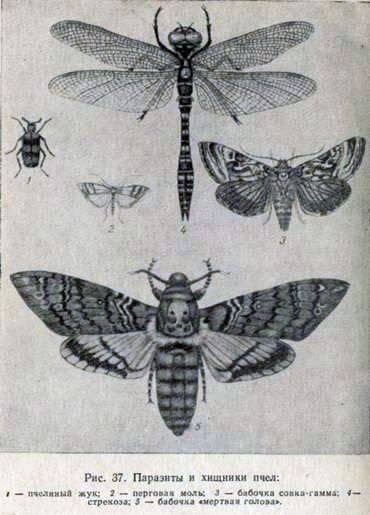Butterfly “dead head"

The butterfly “dead head” (Acherontia atropos L., fig.37) received this name because it has a skull pattern with bones on its back. It is found in the south. It is a large butterfly 50 mm long and in wingspan 120-140 mm, it flies in the evenings and at night. At night, it penetrates the hive into the beehive and eats up to 5-10 g of honey at a time. In addition to the abduction of honey, the butterfly causes great concern to the bees, who massively attack it, and it fights off them with blows of wings.
Eggs put on potatoes and other Solanaceae (nightshade, bleached, dope, belladonna, tobacco), sometimes on plants of other families. From the eggs, caterpillars appear that grow to a length of 6-8 cm. The caterpillar is yellow, with blue stripes on its back and an S-pattern on its posterior end.
Control measures. Zarekachivanie trough wire mesh with the cells available for the passage of bees, or narrowing its height to 8 mm.
Inspection of hives and terrain for the presence of parasites and predators of bees. Pests of bees are found in the apiary and are harmful throughout the year. However, they are more often harmed at the end of winter and in the spring, and predators – in summer and autumn. For the detection of parasites, families and warehouses are inspected, where honeycomb and raw materials are stored, and to inspect the pests, inspect the territory, the neighborhood of the apiary, the hives of the beehives, the hives of honey.
Pests of insects with hard covers are sacrificed in stains and placed in cardboard boxes between layers of cotton wool. Insects with soft covers (larvae and pupae) are placed in bottles with 10% formalin solution, 70% alcohol solution or in undiluted honey. The presence of mice is determined in the winter in families by dead gnawed bees and the presence of mouse excrement in the sub-sea. Identify pests by comparing their sizes, colors and characteristics with their description.
When detecting an apiary of a pest, appropriate measures are taken against it. Against the mice in the autumn put on the hives of the beehives the bars, close up the cracks in the hives, the winter hut; the floor of the winter queen is covered with dry sand. When mice are found in winter, mousetraps are placed in the hibiscus and lures baits with bacteria that kill mice and rats.
Against wax moths in families, mechanical destruction of caterpillars, cocoons and butterflies is applied, nests are cut. In warehouses, honeycombs are hung on the slats a certain distance apart. When storing store cells in stacks, they produce fumigation. Cut out the old unsuitable honeycombs fall asleep with a microbial preparation – entobacterin containing spores of you. thuringiensis, pathogenic for waxy moth caterpillars. Take the necessary measures against other identified pests of bees.
Butterfly “dead head"
